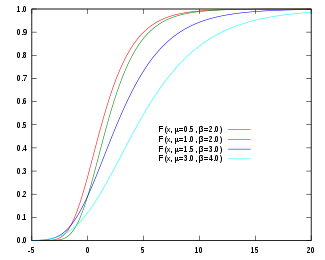This is an old revision of this page, as edited by 209.198.94.10 (talk) at 15:14, 26 March 2013 (Gumbel distribution is not defined at a uniform draw of 0. Updated notation to reflect this.). The present address (URL) is a permanent link to this revision, which may differ significantly from the current revision.
Revision as of 15:14, 26 March 2013 by 209.198.94.10 (talk) (Gumbel distribution is not defined at a uniform draw of 0. Updated notation to reflect this.)(diff) ← Previous revision | Latest revision (diff) | Newer revision → (diff)
Probability density function | |||
Cumulative distribution function | |||
| Parameters |
location (real) scale (real) | ||
|---|---|---|---|
| Support | |||
|
where | |||
| CDF | |||
| Mean | |||
| Median | |||
| Mode | |||
| Variance | |||
| Skewness | |||
| Excess kurtosis | |||
| Entropy | |||
| MGF | |||
| CF | |||
In probability theory and statistics, the Gumbel distribution is used to model the distribution of the maximum (or the minimum) of a number of samples of various distributions. Such a distribution might be used to represent the distribution of the maximum level of a river in a particular year if there was a list of maximum values for the past ten years. It is useful in predicting the chance that an extreme earthquake, flood or other natural disaster will occur.
The potential applicability of the Gumbel distribution to represent the distribution of maxima relates to extreme value theory which indicates that it is likely to be useful if the distribution of the underlying sample data is of the normal or exponential type.
The Gumbel distribution is a particular case of the generalized extreme value distribution (also known as the Fisher-Tippett distribution). It is also known as the log-Weibull distribution and the double exponential distribution (which is sometimes used to refer to the Laplace distribution). It is often incorrectly labelled as Gompertz distribution.
In the latent variable formulation of the multinomial logit model — common in discrete choice theory — the errors of the latent variables follow a Gumbel distribution. This is useful because the difference of two Gumbel-distributed random variables has a logistic distribution.
The Gumbel distribution is named after Emil Julius Gumbel (1891–1966).
Properties
| This section includes a list of references, related reading, or external links, but its sources remain unclear because it lacks inline citations. Please help improve this section by introducing more precise citations. (February 2012) (Learn how and when to remove this message) |

The cumulative distribution function of the Gumbel distribution is
The mode is μ, while the median is and the mean is given by
where = Euler–Mascheroni constant 0.5772.
The standard deviation is
Standard Gumbel distribution
The standard Gumbel distribution is the case where μ = 0 and β = 1 with cumulative distribution function
and probability density function
In this case mode is 0, the median is 0.3665 and the mean is , where this is defined above. The standard deviation is
- 1.2825.
Generating Gumbel variates
Given a random variate U drawn from the uniform distribution in the interval (0, 1], the variate
has a Gumbel distribution with parameters μ and β. This follows from the form of the cumulative distribution function given above.
Related distributions
When the cdf of Y is the converse of the Gumbel standard cumulative distribution, , then Y has a density function that is a Gompertz function: however, Y does not have a Gompertz distribution since the Gompertz distribution is restricted to positive values while Y can take both positive and negative values.
Application

Gumbel has shown that the maximum value (or last order statistic) in a sample of a random variable following an exponential distribution approaches the Gumbel distribution closer with increasing sample size.
In hydrology, therefore, the Gumbel distribution is used to analyze such variables as monthly and annual maximum values of daily rainfall and river discharge volumes, and also to describe droughts.
Gumbel has also shown that the estimator r / (n+1) for the probability of an event - where r is the rank number of the observed value in the data series and n is the total number of observations - is an unbiased estimator of the cumulative probability around the mode of the distribution. Therefore, this estimator is often used as a plotting position.
The blue picture illustrates an example of fitting the Gumbel distribution to ranked maximum one-day October rainfalls showing also the 90% confidence belt based on the binomial distribution. The rainfall data are represented by the plotting position r / (n+1) as part of the cumulative frequency analysis.
See also
- Type-1 Gumbel distribution
- Type-2 Gumbel distribution
- Extreme value theory
- Generalized extreme value distribution
- Fisher–Tippett–Gnedenko theorem
External links
References
- Willemse, W. J. and Kaas, R., "Rational reconstruction of frailty-based mortality models by a generalisation of Gompertz’ law of mortality", Insurance: Mathematics and Economics, 40 (3) (2007), 468–484.
- Gumbel, E.J. 1954. "Statistical theory of extreme values and some practical applications". Applied Mathematics Series, 33. U.S. Department of Commerce, National Bureau of Standards.
- Ritzema (ed.), H.P. (1994). Frequency and Regression Analysis (PDF). Chapter 6 in: Drainage Principles and Applications, Publication 16, International Institute for Land Reclamation and Improvement (ILRI), Wageningen, The Netherlands. pp. 175–224. ISBN 90-70754-33-9.
{{cite book}}:|last=has generic name (help) - Burke, E.J.; Perry R.H.J.; Brown, S.J. (2010) "An extreme value analysis of UK drought and projections of change in the future", Journal of Hydrology















 and the mean is given by
and the mean is given by

 =
=  0.5772.
0.5772.



 0.3665 and the mean is
0.3665 and the mean is  1.2825.
1.2825.
 , then Y has a density function that is a
, then Y has a density function that is a